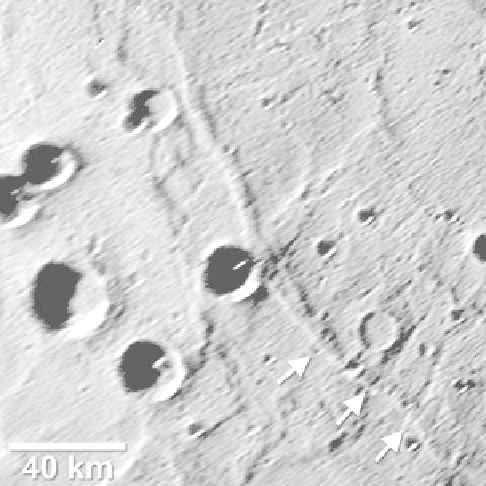Geology Reference
In-Depth Information
the north and northeast, where illumination favors their
detection on the available images.
The interior of the Rembrandt basin is covered with
smooth plains of inferred volcanic origin, although they
might also be impact melt. However, multispectral data
from MESSENGER show that the plains do not have the
same properties as the rim and ejecta, suggesting a differ-
ent composition, and more closely matching other plains
units on Mercury that are considered to be volcanic.
Regardless of origin, Waters and colleagues estimate that
the amount of
oor-
ll must be at least 2 km thick, from
the observation that ejecta from a crater 44 km in diameter
on the basin
oor (
Fig. 5.16
) has the same spectral proper-
ties as the plains, which are different from those of the
basin rim and basin ejecta deposits; thus, the crater did not
excavate through the plains. The estimation of a minimum
thickness of 2 km is based on the depth of excavation
resulting from a 44 km crater.
The interior plains of Rembrandt display a well-
developed pattern of tectonic deformation in the form
of concentric ridges and radial troughs (inferred to be
grabens) and ridges (
Fig. 5.28
). As with the Caloris
basin, these features probably formed as the volcanic
plains materials cooled. Superposition of smooth, lightly
cratered plains over some of these features near the
center of the basin suggests that plains emplacement
and tectonic deformation were interspersed. The basin
was later deformed by global-scale tectonics, as is evi-
denced by the lobate scarp that cuts across the northwest
part of Rembrandt (
Fig. 5.27
) and is more than 1,000 km
long.
5.5.4 Volcanic features
The low resolution of the Mariner 10 images precluded
the de
nitive identi
cation of volcanism on Mercury. The
smooth plains were inferred to be volcanic, not on the
basis of distinctive features such as
ows and vents, but
more by default because there seemed to be no other
mechanism to explain their relative youth. For example,
while impact melt and ejecta deposits can form smooth
deposits, the smooth plains in the Caloris basin are much
younger than the impact that formed the basin, and there
are no young, large impact structures that could account
for their emplacement as ejecta.
Hints of volcanic origins for some smooth plains came
from carefully processed Mariner 10 color data, which
show that some smooth plains embay older terrains and
have different spectral properties. These results are now
con
rmed with MESSENGER multispectral data and
images that clearly show numerous morphologic fea-
tures indicative of volcanism, including vents and lobate
lava
flows. For example,
Fig. 5.29
shows a feature ana-
lyzed by Jim Head of Brown University and colleagues
(Head et al.,
2008
) in the Caloris basin. It includes a
dome or shield-shaped structure about 80 km by 60 km
that includes irregular-shaped depressions surrounded
by bright material with diffuse margins. This feature is
interpreted as a volcano with multiple vents, some of
which erupted bright pyroclastic materials. This is only
one of several similar structures imaged in the southern
part of the Caloris basin. Similar features are seen in
other areas of Mercury, including pits that could repre-
sent collapse over magma chambers and explosive vents
(
Fig. 5.30
).
Intrusive activity also has probably taken place in
Mercury
s crust, as possibly reflected in floor-fractured
craters similar to those seen on the Moon. Some of the
ridge structures, described below, could be the surface
expression of dikes, as might be the troughs of Pantheon
Fossae (
Fig. 5.25
).
'
Figure 5.28. An image mosaic of the southwest part of the plains in
Rembrandt crater showing the radial troughs (arrows) that cut across
concentric ridges; the area shown is 160 km across (NASA
MESSENGER NAC 131766401M and 131766417M).



